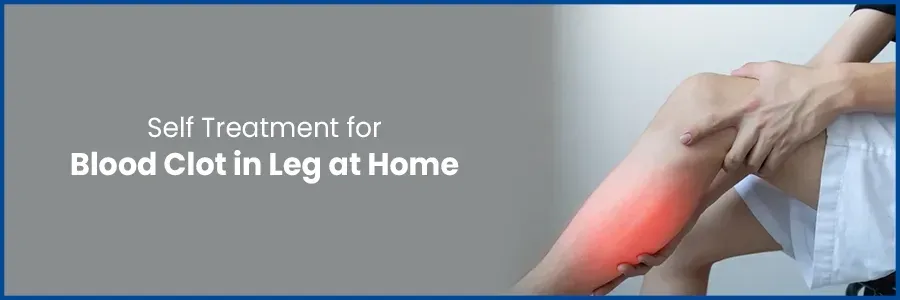- Cardiology 84
- Dermatology 45
- Endocrinology 33
- ENT 16
- Fertility 190
- Gastroenterology 78
- General-Medicine 81
- Gynecology 80
- Hematology 19
- Infectious-Diseases 33
- Neurology 52
- Oncology 34
- Ophthalmology 23
- Orthopedics 69
- Pediatrics 31
- Procedure 23
- Public-Health 144
- Pulmonology 59
- Radiology 8
- Urology 68
- Wellness 161
- Woman-and-child 77

Home Treatments for Blood Clot in Leg and Self-Care Tips
Dealing with a blood clot in the leg, also known as deep vein thrombosis (DVT), requires prompt attention and appropriate care. Here, we discuss effective home treatments and remedies that can aid in managing this condition.
Secure your health with a second opinion. Make informed decisions and book your appointment today!
Get A Second OpinionSymptoms of Blood Clot in Leg
Here are the maximum common signs and symptoms that might show there may be a blood clot in your leg. Knowing those symptoms is crucial so that you can get help quickly.
- Swelling
- Pain or Tenderness
- Skin Discoloration
- Warmth and Redness
- Enlarged Veins
- Leg Fatigue/Heaviness
How to Check for DVT at Home
While not definitive, there are methods to check for signs of DVT at home:
- Homan's Sign: Gently flex your ankle upwards towards your knee while lying down. Pain behind the knee or in the calf might indicate a blood clot.
- Measure Leg Circumference: Compare the circumference of both legs. A noticeable difference may suggest swelling due to a clot.
Ready to take control of your health journey? Book your appointment now and start your path towards wellness today!
Book an AppointmentTreatment for Blood Clot in Leg at Home
- Elevation: Keep your leg elevated above heart level to reduce swelling and improve blood flow.
- Compression: Use compression stockings as directed by your healthcare provider to prevent complications and reduce discomfort.
- Exercise: Perform light exercises like ankle pumps and leg stretches to promote circulation.
- Hydration: Stay well-hydrated to maintain healthy blood viscosity.
Home Remedies for Blood Clot
In addition to prescribed treatments, consider these home remedies:
- Warm Compress: Apply a warm compress to the affected area to alleviate pain and promote relaxation.
- Herbal Supplements: Certain herbs like ginger and turmeric may have anti-inflammatory properties that could aid in clot management.
- Dietary Adjustments: Incorporate foods rich in omega-3 fatty acids and antioxidants to support vascular health.
Deep Vein Thrombosis Treatment at Home
Managing DVT at home involves diligent care and monitoring:
- Follow Medical Advice: Always adhere to your healthcare provider's instructions regarding medications and lifestyle modifications.
- Monitor Symptoms: Keep track of any changes in symptoms and report them promptly to your doctor.
- Avoid Prolonged Sitting: Take breaks to move around and avoid long periods of immobility, especially during travel or desk work.
Conclusion
Managing a blood clot in the leg requires a proactive approach combining medical treatment and self-care at home. By following these guidelines and seeking timely medical advice, you can effectively manage DVT and promote leg health.
Frequently Asked Questions
No, blood clots in the leg typically do not dissolve on their own. It's important to seek medical attention for proper treatment. Ignoring a blood clot can lead to serious complications.
The initial symptoms of a blood clot in the leg may include swelling, pain, warmth, red or discolored skin, enlarged veins, or a feeling of tiredness. If you experience these symptoms, it's crucial to consult a doctor as soon as possible.
Avoiding foods that can increase clotting is important. This includes foods high in vitamin K (like leafy greens) and those high in saturated fats. Maintaining a balanced and healthy diet is essential, and it's advisable to consult your doctor for personalized dietary advice.
Doctors use specialized tests such as ultrasound or CT scans to confirm the presence of a blood clot. These tests allow them to visualize inside your body and assess for clots. If you suspect you have a blood clot, it's crucial to discuss with your doctor who can determine the necessary tests and treatment.
To treat a blood clot in the leg (deep vein thrombosis or DVT), medical intervention is crucial. Treatment typically involves blood thinners (anticoagulants) to prevent the clot from growing or breaking loose. In some cases, clot-dissolving medications or surgical procedures may be necessary. Prompt medical attention is essential to prevent complications like pulmonary embolism.
Treatment for a blood clot in the leg typically involves anticoagulant medications to prevent further clotting and allow existing clots to dissolve. Hospital care may include monitoring, compression stockings, and in severe cases, procedures like thrombolysis or surgery to remove the clot.

- Cardiology 2132
- Dermatology 168
- Endocrinology 135
- ENT 97
- Fertility 217
- Gastroenterology 232
- General 478
- General-Medicine 1685
- Gynecology 169
- Hematology 85
- Infectious-Diseases 208
- Neurology 207
- Oncology 345
- Ophthalmology 65
- Orthopedics 187
- Pediatrics 83
- Procedure 72
- Public-Health 209
- Pulmonology 126
- Radiology 13
- Second Opinion 311
- Urology 294
- Wellness 600
- Woman-and-child 447
- Others 10217
Related Blogs
If you have any questions, please fill out the enquiry form or call us, and we will get back to you promptly.
040-68334455